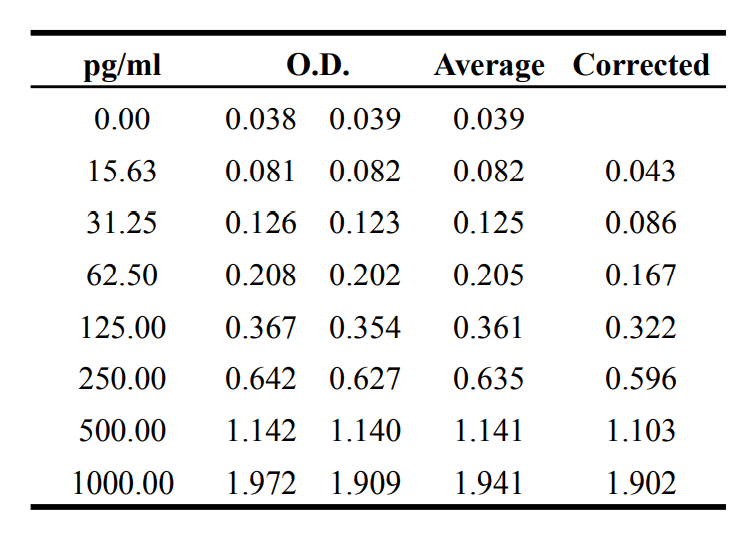
Mouse Fas/TNFRSF6/CD95 ELISA Kit
$350.00 – $450.00
| Sample Type | Serum, plasma, cell culture supernatant, and other biological samples |
|---|---|
| Sample Volume | 50 μL |
| Sensitivity | 2.34 pg/mL |
| Range | 15.63 pg/mL – 1000 pg/mL |
| Assay Time | 3.5 h |
| Recovery | 75% – 96% |
| Average Recovery | 0.85 |
| Intra Precision | 2.1% – 7.6% |
| Inter-Precision | 2.1%-7.8% |
| Platform | ELISA |
| Plate | Detachable 96-well plate |
| Size | 96T/48T |
| Storage | If the reagent kit is unopened, it should be stored at 4℃. However, if it has been opened, the standard solution should be stored at -20℃, while the other components should be stored at 4℃. |
| Delivery | 4℃ blue ice transportation |
| Components | 96-well polystyrene enzyme-linked immunosorbent assay (ELISA) plate coated with anti-Fas monoclonal antibody Mouse Fas freeze-dried standard Fas detect Antibody Standard Diluent Assay Buffer(10×) Substrate TMB Stop Solution Washing Buffer(20×) Sealing Film |
| Assay Principle | This kit utilizes the double antibody sandwich enzyme-linked immunosorbent assay (ELISA) detection technique.Specific anti-mouse Fas antibodies are precoated on a high-affinity ELISA plate. Standard samples, test samples, and biotinylated detection antibodies are added to the wells of the ELISA plate. After incubation, Fas present in the samples binds to the solid-phase antibodies and the detection antibodies. After washing to remove unbound substances, streptavidin-HRP labeled with horseradish peroxidase is added. After washing, a colorimetric substrate, TMB, is added and the plate is incubated in the dark for color development. The intensity of the color reaction is directly proportional to the concentration of Fas in the samples.A stop solution is added to terminate the reaction, and the absorbance value is measured at a wavelength of 450 nm (with a reference wavelength range of 570-630 nm). |
Targets
FAS
FAS Target Infomation Overview
- Target Symbol: FAS, Fas cell surface death receptor
- Gene Groups: CD molecules; Tumor necrosis factor receptor superfamily; Death inducing signaling complex
- Alias: CD95; APO-1
- Previous Names: FAS1; APT1; TNFRSF6
- Alias Names: TNF receptor superfamily member 6; tumor necrosis factor receptor superfamily, member 6; Fas (TNF receptor superfamily, member 6)
FAS, Fas cell surface death receptor Target Infomation by Species
[su_tabs][su_tab title=”Human” disabled=”no” anchor=”” url=”” target=”blank” class=”tab-human”]
Human FAS Target Information
- Target Symbol: FAS, Fas cell surface death receptor
- Alias:
- ALPS1A
- APO-1
- apo-1 antigen
- APO-1 cell surface antigen
- apoptosis antigen 1
- apoptosis signaling receptor FAS
- apoptosis-mediating surface antigen FAS
- APT1
- CD95
- CD95 antigen
- Delta Fas/APO-1/CD95
- Fas (TNF receptor superfamily, member 6)
- FAS 827dupA
- Fas AMA
- Fas antigen
- FAS receptor variant 9
- FAS1
- FASLG receptor
- FASTM
- mutant tumor necrosis receptor superfamily member 6
- RP11-399O19.9
- TNF receptor superfamily member 6
- TNFRSF6
- tumor necrosis factor receptor superfamily member 6
- tumor necrosis factor receptor superfamily, member 6
- NCBI_Gene: 355
- UniProtKB: P25445
Human FAS Predicted Functions
Enables calmodulin binding activity; identical protein binding activity; and kinase binding activity. Involved in several processes, including cell surface receptor signaling pathway; positive regulation of cellular protein metabolic process; and regulation of signal transduction. Acts upstream of or within apoptotic process. Located in several cellular components, including cell surface; membrane raft; and nuclear body. Part of CD95 death-inducing signaling complex. Implicated in several diseases, including autoimmune disease (multiple); cystic fibrosis; hematologic cancer (multiple); pre-eclampsia (multiple); and urinary system cancer (multiple). Biomarker of several diseases, including autoimmune disease (multiple); eye disease (multiple); gastrointestinal system cancer (multiple); hematologic cancer (multiple); and neurodegenerative disease (multiple).
[/su_tab]
[su_tab title=”Mouse” disabled=”no” anchor=”” url=”” target=”blank” class=”tab-mouse”]
Mouse Fas Target Information
- Target Symbol: Fas, Fas (TNF receptor superfamily member 6)
- Alias:
- AI196731
- APO-1
- CD95
- expressed sequence AI196731
- lpr
- lymphoproliferation
- TNF receptor superfamily member 6
- TNFR6
- Tnfrsf6
- NCBI_Gene: 14102
Mouse Fas Predicted Functions
Enables identical protein binding activity. Involved in positive regulation of protein-containing complex assembly. Acts upstream of or within several processes, including extrinsic apoptotic signaling pathway; hematopoietic or lymphoid organ development; and regulation of hemopoiesis. Located in external side of plasma membrane and extracellular region. Part of CD95 death-inducing signaling complex. Is expressed in several structures, including alimentary system; brain; genitourinary system; hemolymphoid system gland; and liver and biliary system. Used to study Sjogren’s syndrome; autoimmune lymphoproliferative syndrome; systemic lupus erythematosus; and type 1 diabetes mellitus. Human ortholog(s) of this gene implicated in several diseases, including autoimmune disease (multiple); cystic fibrosis; hematologic cancer (multiple); pre-eclampsia (multiple); and urinary system cancer (multiple). Orthologous to human FAS (Fas cell surface death receptor).
[/su_tab]
[su_tab title=”Rat” disabled=”no” anchor=”” url=”” target=”blank” class=”tab-rat”]
Rat Fas Target Information
- Target Symbol: Fas, Fas cell surface death receptor
- Alias:
- apo-1 antigen
- apoptosis-mediating surface antigen FAS
- CD95 antigen
- Fas (TNF receptor superfamily, member 6)
- Fas antigen (ATP1)
- Fas receptor
- FASLG receptor
- Tnfrsf6
- tumor necrosis factor receptor superfamily member 6
- Tumor necrosis factor receptor superfamily, member 6
- NCBI_Gene: 246097
Rat Fas Predicted Functions
Enables protease binding activity and tumor necrosis factor-activated receptor activity. Involved in several processes, including cellular response to cytokine stimulus; cellular response to estrogen stimulus; and nervous system development. Located in several cellular components, including apical dendrite; apical plasma membrane; and sarcolemma. Part of CD95 death-inducing signaling complex. Used to study IgA glomerulonephritis; brain glioma; pre-malignant neoplasm; retinal detachment; and transient cerebral ischemia. Biomarker of several diseases, including abdominal obesity-metabolic syndrome 1; artery disease (multiple); brain ischemia (multiple); eye disease (multiple); and liver disease (multiple). Human ortholog(s) of this gene implicated in several diseases, including autoimmune disease (multiple); cystic fibrosis; hematologic cancer (multiple); pre-eclampsia (multiple); and urinary system cancer (multiple). Orthologous to human FAS (Fas cell surface death receptor).
[/su_tab][/su_tabs]
FAS Target News
[catlist tags=”fas” template=targetnews thumbnail=yes thumbnail_class=”related-post-media clr” thumbnail_size=833]





